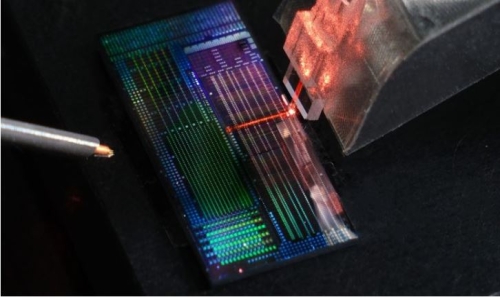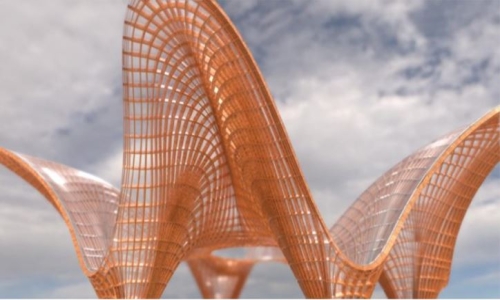


 8:4:24
8:4:24  2019-03-12
2019-03-12  1199
1199

Printing layers of skin to help treat chronic wounds or burns may be on the horizon, thanks to a newly developed mobile skin bioprinting system.
Scientists at the Wake Forest Institute for Regenerative Medicine (WFIRM) in Winston-Salem, NC, have created a bioprinter that uses a person's own skin cells to create layers of new skin and apply them directly to the wound.
A new paper, which now appears in the journal Scientific Reports, details the development of this new technology.
The procedure involves harvesting major skin cells called dermal fibroblasts and epidermal keratinocytes from a biopsy of a person's normal skin tissue.
The scientists expanded the cells and mixed them into a hydrogel. They then placed them into the bioprinter, which scans the person's wound, feeds the data into the software, and tells the device where to place the printed layers of skin.
The resulting material is uniquely printed to match the exact areas in a person's wound where it is needed without the need for a donor skin graft.
This technique can replicate the natural function of skin and accelerate how skin naturally forms, which means that healing can take less time and has fewer risks.
"The unique aspect of this technology is the mobility of the system and the ability to provide on-site management of extensive wounds by scanning and measuring them in order to deposit the cells directly where they are needed to create skin." – Lead study author Sean Murphy, Ph.D.
Chronic wounds are difficult to treat
A wound normally takes up to 4–6 weeks to heal, depending on severity and size. However, when it does not heal within this timeframe, doctors consider it a chronic wound. Many factors can cause a chronic wound, including diabetes and poor nutrition.
There are many ways that healthcare providers attempt to heal a chronic wound. Wound dressing is an important part of the care and healing of wounds, but these vary in price and effectiveness.
Skin grafts are another option for both chronic wounds and burns that encompass a large surface area of tissue. Skin grafts can either come from another area of the person's body, called autologous sources, or in the form of skin substitutes.
Bioprinted skin layers may be the next revolution in wound healing. Dr. James Yoo, Ph.D., who led the research team, explains that bioprinted layers of skin help people start their healing process much sooner.
He also mentions that other methods of treating and closing wounds do not really help create skin, as this method would.
The researchers note that skin grafts are common, but they can have multiple disadvantages. For example, autologous grafts can be limited due to a shortage of healthy tissue. Also, donor skin grafts can bring a risk of tissue rejection.
The new bioprinter helps ameliorate these risks because it helps skin form outward from the center of the wound, which only happens when a person's own cells are used in its creation.
'No significant difference'
The findings are encouraging, but our in-house Research Editor, Yella Hewings-Martin, Ph.D., said:
"The bioprinter successfully delivered cells to the surface of the wound. But there was no significant difference in how fast the wounds healed when the authors compared their device with cells applied in a spray, a method that many clinics use already."
She continued, "There was some evidence that the surface of the skin healed faster, but it remains to be seen what benefit a bioprinter can bring over existing technology."
While the researchers have demonstrated how this method works on demo models, the next step is to plan human clinical trials.
There is no timeframe for when this technology might find its way to a person's bedside and form part of standard wound healing treatment. However, it is a promising start to a method that may change how healthcare providers approach wound care in the future.
By Monica Beyer, Medical News Today
Reality Of Islam |
|

A new chip-

A large inf

Choosing th

A new NURBS
 9:3:43
9:3:43
 2018-11-05
2018-11-05
10 benefits of Marriage in Islam
 7:5:22
7:5:22
 2019-04-08
2019-04-08
benefits of reciting surat yunus, hud &
 9:45:7
9:45:7
 2018-12-24
2018-12-24
advantages & disadvantages of divorce
 11:35:12
11:35:12
 2018-06-10
2018-06-10
 6:0:51
6:0:51
 2018-10-16
2018-10-16
 12:47:1
12:47:1
 2022-12-20
2022-12-20
 4:26:43
4:26:43
 2022-02-21
2022-02-21
 8:39:51
8:39:51
 2022-09-23
2022-09-23
 3:43:50
3:43:50
 2022-11-05
2022-11-05
 2:2:13
2:2:13
 2022-10-08
2022-10-08
 6:28:21
6:28:21
 2022-12-20
2022-12-20
 9:30:2
9:30:2
 2021-11-12
2021-11-12
 5:41:46
5:41:46
 2023-03-18
2023-03-18
| LATEST |